Intercom for Customer Experience: Features, Pricing, and Review

Looking for an effective customer experience tool and wondering if Intercom is the best option for your SaaS company?
With numerous Intercom alternatives, it can be challenging to make a final decision.
In this article, we’ll delve into precisely that – helping you determine whether Intercom is the ideal choice for your customer experience needs. We’ll explore its features, pricing, and offer a comprehensive review to aid in your decision-making process.
Let’s get started!
TL;DR
- Intercom is a good choice for customer experience and it comes with features such as user segmentation, interactive user guides, in-app support, and self service support.
- While Intercom is a flexible and popular solution when it comes to customer service, there are certain use cases where it will likely fall short compared to other options.
- If you’re in any of these scenarios, you should look for an alternative platform for your needs:
- Onboarding and Adoption: If onboarding new users and driving product adoption are your primary use cases then Intercom may not be the best choice. Its Product Tours add-on is quite limited compared to dedicated adoption platforms (and costs almost as much).
- Budget Constraints: Early-stage SaaS companies with a limited budget should be wary of Intercom’s pricing model. Its entry-level plan starts at an affordable $74/month but getting the Product Tours add-on and extra team seats could lead to your subscription cost skyrocketing.
- Mobile Apps: While Intercom’s core features like the live chat messenger work on mobile apps, its product tours add-on is only compatible with desktop platforms.
- If you’re looking for a better option for customer experience, Userpilot exceeds both functionality and value for money compared to Intercom
- Ready to see Userpilot in action? Schedule a demo today to explore its powerful customer experience capabilities firsthand.
![]()
Looking for a Better Alternative for Customer Experience? Try Userpilot

What is Intercom?
Intercom is a customer service platform. It offers customizable live chat widgets, omnichannel support capabilities, and integrations with over 300 apps. While Intercom is primarily a support solution, it does have add-ons that offer other functionalities such as product tours.
The Product Tours add-on contains features that aid onboarding, adoption, and feature discovery. Intercom’s product tours can include UI patterns like modals and tooltips as well as other media formats such as microvideos.
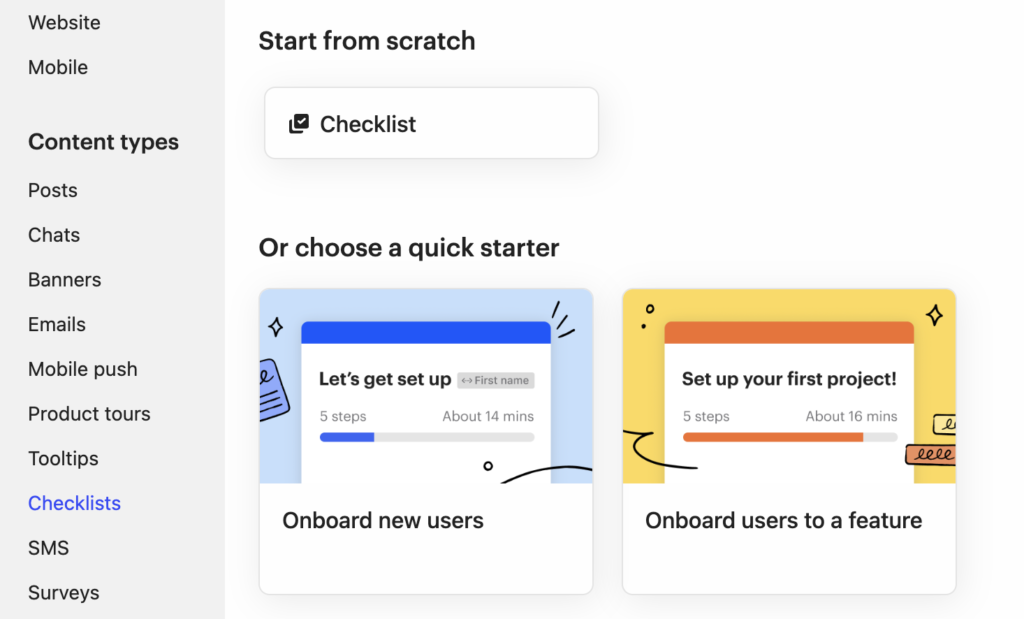
Must have features of customer experience tools
Here’s what to look for before choosing your customer experience tool:
- UI patterns such as tooltips, driven action, and interactive walkthroughs to help you implement proactive support.
- Customer engagement tracking for collecting customer experience data.
- Microsurveys for collecting customer experience feedback or building user persona for product personalization.
- Advanced segmentation options such as need-based and behavioral segmentation to personalize your user’s experience based on their needs and goals.
- Analytics dashboard to collect customer experience insights — by tracking user data events, feature usage, survey statistics, etc.
Intercom features for customer experience
User onboarding educates new customers, teaches them how to use your product, and helps them get the most value in the least amount of time.
Intercom’s Product Tours add-on includes UI patterns and onboarding analytics that can prove helpful (if you’re willing to pay extra for them).
This will cost you an additional $199/month on top of what you’re currently paying for your base Intercom subscription. This puts its pricing on par with dedicated onboarding/adoption tools despite lacking feature parity.
Here’s an overview of Intercom’s Product Tours add-on:
- UI Patterns: Intercom’s product tours for onboarding come with an expansive selection of UI patterns like tooltips, banners, surveys, in-app checklists, and multi-step flows. You can also use communication features in your tours such as SMS messages or live chat widgets.
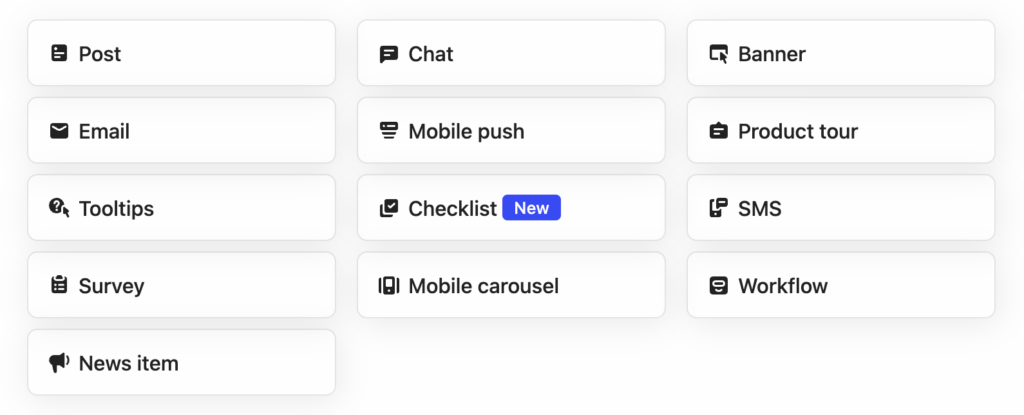
- Onboarding Analytics: Intercom shows you detailed analytics for each product tour such as the total number of views, overall completion rate, percentage of users who achieved a particular goal, and how many issues were encountered during the tour.
Intercom’s user segmentation
User segmentation lets you divide customers based on their needs and use cases then deliver a personalized experience to each one. Intercom has three pre-defined segments, AND/OR filtering, and detailed company profiles that lets you analyze your entire user base.
Here are the types of user segmentation you can use on Intercom:
- Pre-Defined Segments: Intercom has three built-in segments. The “Active” segment is for any users who have been active in the last 30 days, “New” includes anyone who has signed up in the past 24 hours, and “Slipping away” is for those who haven’t been active in the past 30 days.
- Segmentation Filters: Intercom lets you create custom segments using AND/OR rules to combine attributes. Do note that overly complex segments may take longer to display results (or in some cases fail altogether and ask you to simplify your filter settings).

- Company Profiles: Intercom’s segmentation capabilities also let you view users on a company level. You’ll be able to view all the people from a certain company, see their email, monitor engagement metrics, and review all conversations that they’ve been a part of.
Intercom’s interactive user guides
Interactive user guides are more effective than linear tours because they let users learn by doing.
To build interactive user guides with Intercom, you’ll need to get the Product Tours add-on which costs $199/month in addition to your base subscription fee.
Here’s how you can use Intercom to build interactive guides:
- Tour Targeting: Intercom product tours can be set to appear on specific pages, at certain days/times, and be triggered by conditions or events. Trigger conditions include signup date, last seen, last contacted, etc., while events could be subscription upgrades or recent purchases.
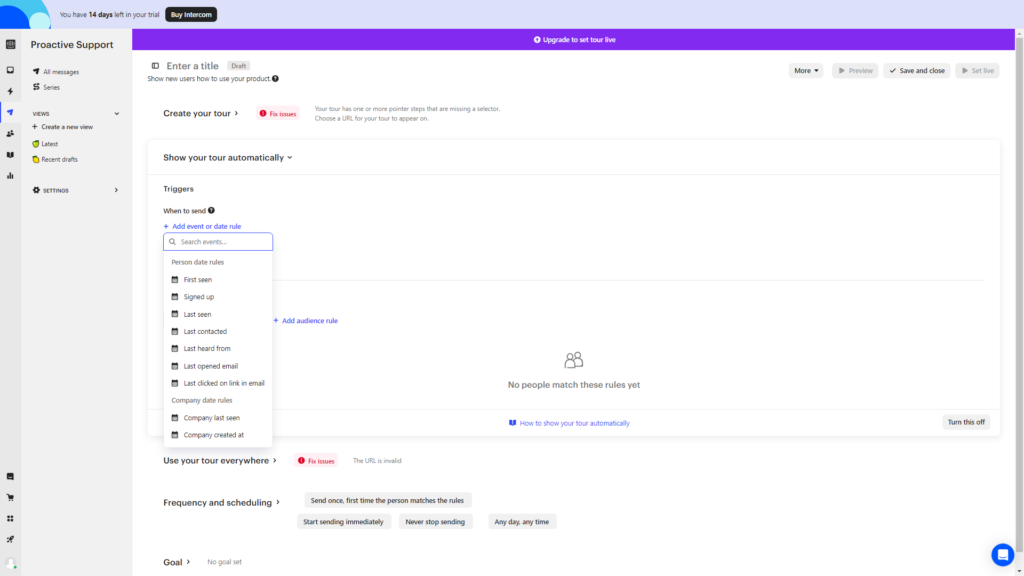
- Interactive Popups: You can use numerous UI patterns when building interactive walkthroughs with Intercom. These include tooltips, checklists, surveys, and mobile carousels or push notifications. You can also add banners, announcements, or multi-step tours.

- Guide Analytics: Intercom’s reporting shows you which guides get the most views, how satisfied users are, the number of conversations, and when it was last updated. Any product tours created with Intecom will also have a separate analytics dashboard to track performance.
Intercom’s in-app support
Intercom’s in-app support capabilities center around its live chat widget and help center builder. The help center supports 45 languages, countless third-party integrations from the Intercom App Store, and automated welcome messages.
Here’s an overview of Intercom’s in-app support capabilities:
- Live Chat: Intercom’s live chat is highly customizable, compatible with countless integrations, and lets you style its appearance to bring it in line with your existing product UI (or brand palette). You can also reorder buttons or toggle their visibility as needed.
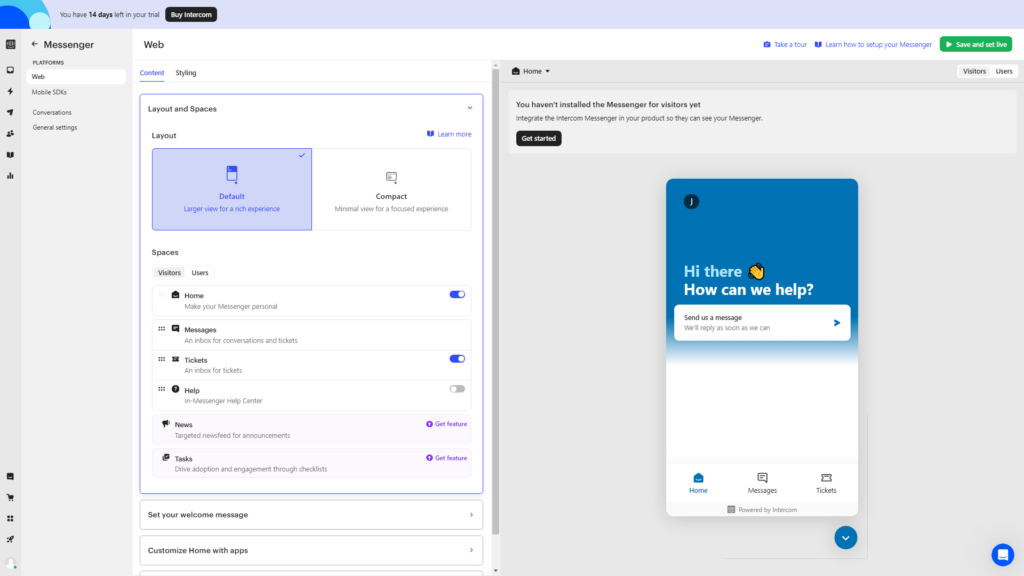
- Help Center: Intercom’s help center can be set up in multiple languages, use custom domains, and integrated with third-party apps. You’ll also be able to change up the layout, insert your logo, and set a (multi-lingual) welcome message to greet users who land at your help center.
Note: Intercom’s multilingual help centers are only available on the Pro tier and higher which means users on the entry-level Starter plan ($74/month) won’t be able to use this feature. Help articles aren’t automatically translated so you’ll need to rewrite them manually as well.

- Content Analytics: Intercom’s content engagement analytics can show you granular insights on the performance of each help center article. You’ll be able to see the number of views, conversations, and reactions and then compare those numbers for different date ranges.

Intercom’s self service support
Self-service support helps users solve their own problems so they get faster resolution times without needing to take up the time of your support representatives. Intercom has self-service support features like a help center, chatbot, and third-party knowledge base integrations.
Here’s how you can use Intercom to create a self-service customer experience:
- Help Center: The Intercom help center lets you publish resources in multiple languages, host them on a custom domain, and embed third-party apps if needed. Any help articles published here will also be used to feed information to your support chatbots down the line.
Note: Intercom’s multilingual help centers are only available on the Pro tier and higher which means users on the entry-level Starter plan ($74/month) won’t be able to use this feature. Help articles aren’t automatically translated so you’ll need to rewrite them manually as well.
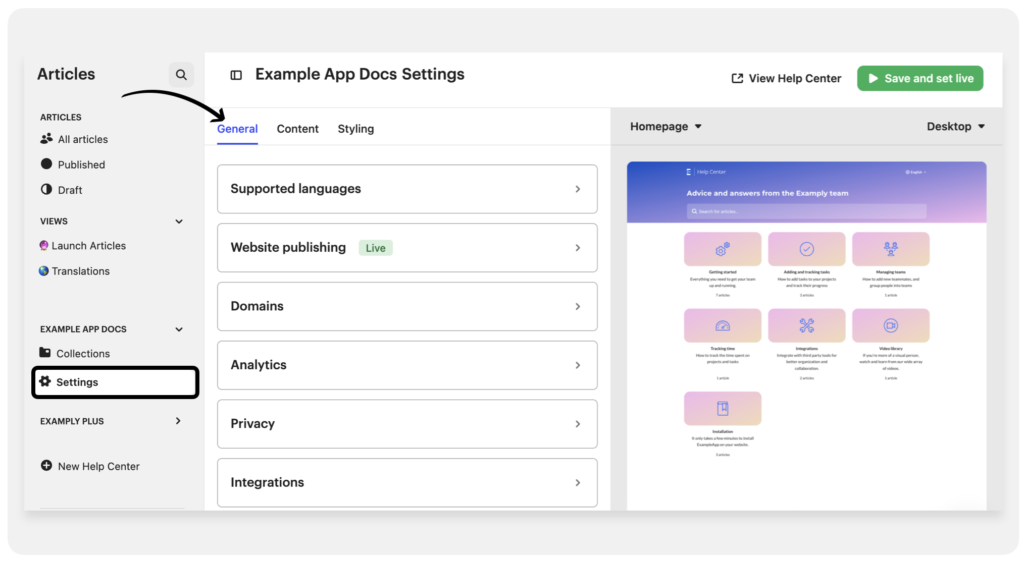
- Fin Chatbot: The Fin chatbot is built on GPT-4 which allows it to respond naturally while drawing data from multiple sources. It can reference articles in your help center, look at conversation data, search through public URLs, or pull information from integrations.
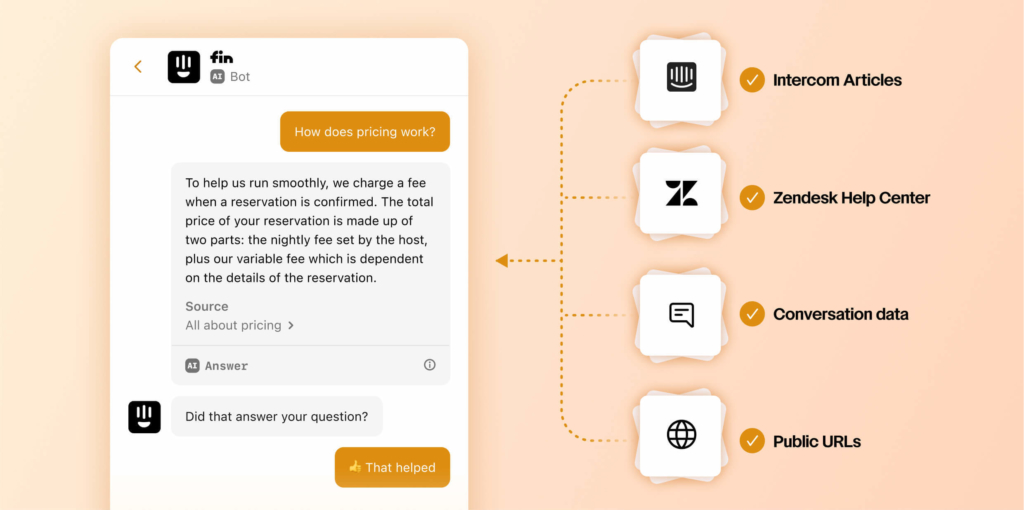
- Third-Party Integrations: Intercom has integrations for external knowledge base solutions. There are over 20 knowledge base tools that Intercom can integrate with to import articles, videos, and other support data. This includes Zendesk, Freshdesk, HelpDocs, and more if you are on the Pro plan (the Starter plan drastically restricts available integrations).
What are the pros and cons of Intercom?
Intercom’s pros
- Robust Live Chat: Intercom’s live chat widget is the most popular feature on the platform. You’ll be able to style the widget in accordance with your brand colors, choose which support options customers will see, and insert apps to create a self-serve experience.
- Product Tours Add-On: In addition to Intercom’s customer service capabilities, its Product Tours add-on offers support to new users during the onboarding and adoption phases. Features include a no-code builder, audience targeting, analytics reporting, and more.
- Extensive Integration Gallery: If Intercom’s built-in support/onboarding features aren’t enough, you can expand its native functionality using third-party integrations. Intercom’s App Store has over 300 tools to choose from with new solutions being added regularly.
Intercom’s cons
- Buggy Search Function: Searching through support tickets is a core task for Intercom users but this process is often laggy or refuses to work altogether by freezing the page. Intercom’s searchability shortcomings have been present for years with no fixes released.
- Confusing Navigation Interface: While Intercom does have a wide array of features, its user interface isn’t intuitive and it’ll take a lot of memorization (or trial-and-error) to figure out where everything is. There are many features that can (and should) be combined into one page.
- Support Response Times: Intercom is a customer service platform which is why it’s ironic that their support team isn’t able to reliably respond in a timely manner. Numerous customers have noted slow response times from support representatives when reviewing Intercom.
What do users say about Intercom?
Intercom users were impressed with the interaction features such as emojis, GIFs, and avatars:
“I really like the fact that you can send emojis, have an avatar, interact with the client and know what their tastes are as such, it is very interactive to the point that you can jump between chats recognizing each of the clients/agents.”
 Of course, other customers were upset by the lack of transparent billing, inadequate support experience, constant upsells, and restrictive feature limitations:
Of course, other customers were upset by the lack of transparent billing, inadequate support experience, constant upsells, and restrictive feature limitations:
“Purposely opaque and dishonest billing systems.
Incompetent staff.
Once you have it installed they exploit you for CONSTANT fee hikes.
Constant pitches to upgrade plans and required extra fees.
Unnecessary limitations on features”

Intercom’s pricing
Intercom’s plans start at $74/month on the entry-level plan and use custom pricing for the Pro tier or higher. There’s no free version available, but Intercom does offer a 14-day free trial that lets you test all features on the Starter tier before upgrading to a paid subscription.
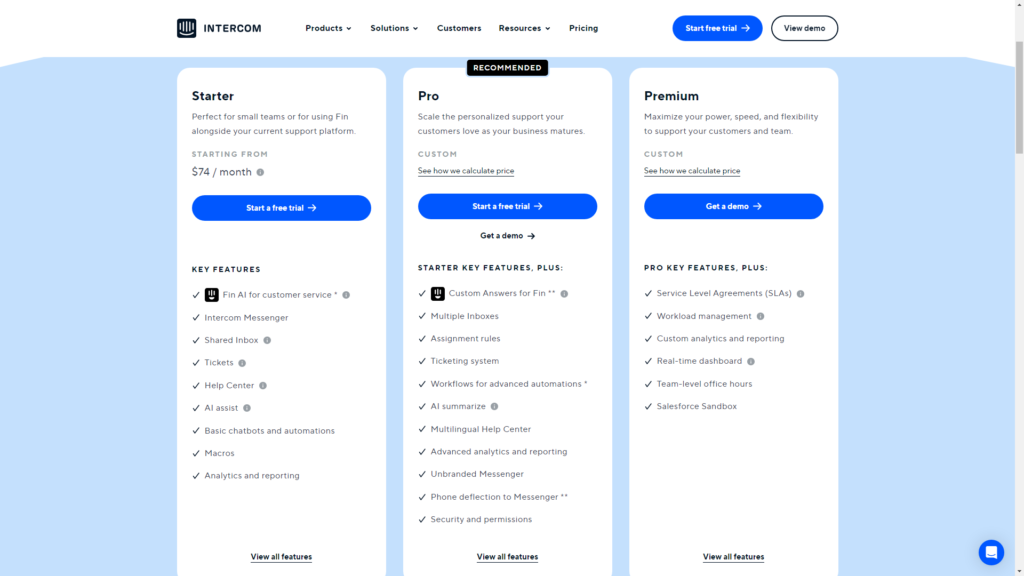
Intercom has three paid plans to choose from and different add-ons priced separately:
- Starter: Starts at $74/month and includes two team seats, and features like the messenger widget, automated chatbots, shared inbox, real-time tickets, help center, macros, and basic analytics reporting capabilities.
- Pro: Custom pricing based on the number of team seats and MAUs. It includes features like multiple inboxes, assignment rules, ticketing systems, localized help centers, and advanced automation/analytics.
- Premium: Custom pricing based on the number of team seats and MAUs. It includes features like a real-time dashboard, custom analytics, workload management, and a service level agreement.
In addition to the base subscription cost, you’ll need to pay an additional $199/month if you want to use the Product Tours add-on. This means that, even on the Starter plan, you’d still be paying almost $300/month in total if you get the Product Tours add-on to go with it.
3 Reasons why you might need a Intercom alternative
While Intercom is a flexible and popular solution when it comes to customer service, there are certain use cases where it will likely fall short compared to other options.
If you’re in any of these scenarios, you should look for an alternative platform for your needs:
- Onboarding and Adoption: If onboarding new users and driving product adoption are your primary use cases then Intercom may not be the best choice. Its Product Tours add-on is quite limited compared to dedicated adoption platforms (and costs almost as much).
- Budget Constraints: Early-stage SaaS companies with a limited budget should be wary of Intercom’s pricing model. Its entry-level plan starts at an affordable $74/month but getting the Product Tours add-on and extra team seats could lead to your subscription cost skyrocketing.
- Mobile Apps: While Intercom’s core features like the live chat messenger work on mobile apps, its product tours add-on is only compatible with desktop platforms.
Userpilot – A better alternative for customer experience
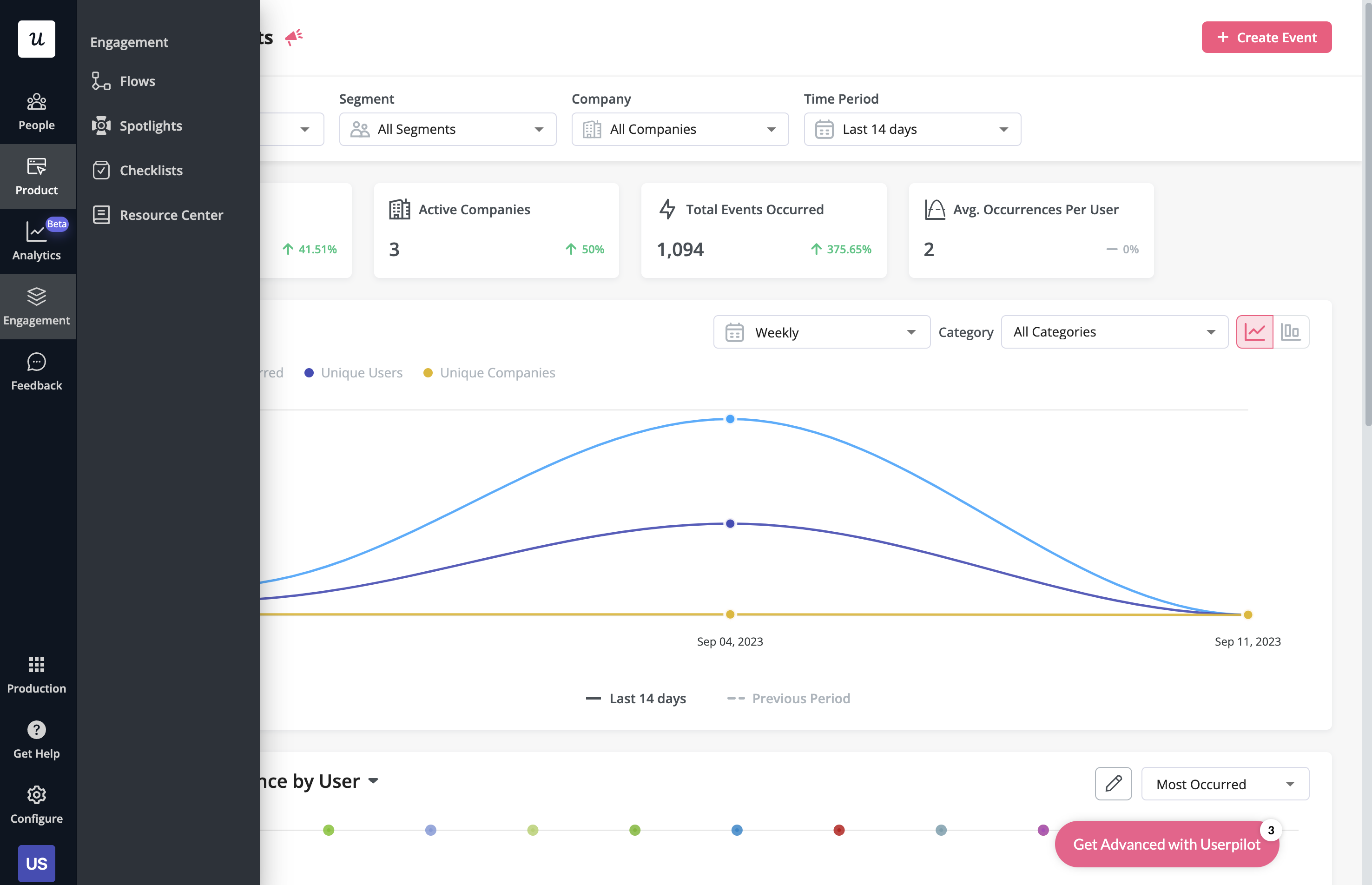 User onboarding is a crucial part of the customer journey as it speeds up the adoption process and increases retention rates. Onboarding is one of Userpilot’s core use cases along with product growth analytics and user feedback, so it has plenty of features that you can utilize.
User onboarding is a crucial part of the customer journey as it speeds up the adoption process and increases retention rates. Onboarding is one of Userpilot’s core use cases along with product growth analytics and user feedback, so it has plenty of features that you can utilize.
Here are some Userpilot features you can use when onboarding new users:
- No-code builder: Creating flows with Userpilot is as simple as installing the Chrome extension, selecting the UI patterns you’d like to use, and then editing the content/settings to suit your use case. You can also use templates to create modals, slideouts, tooltips, and driven actions.
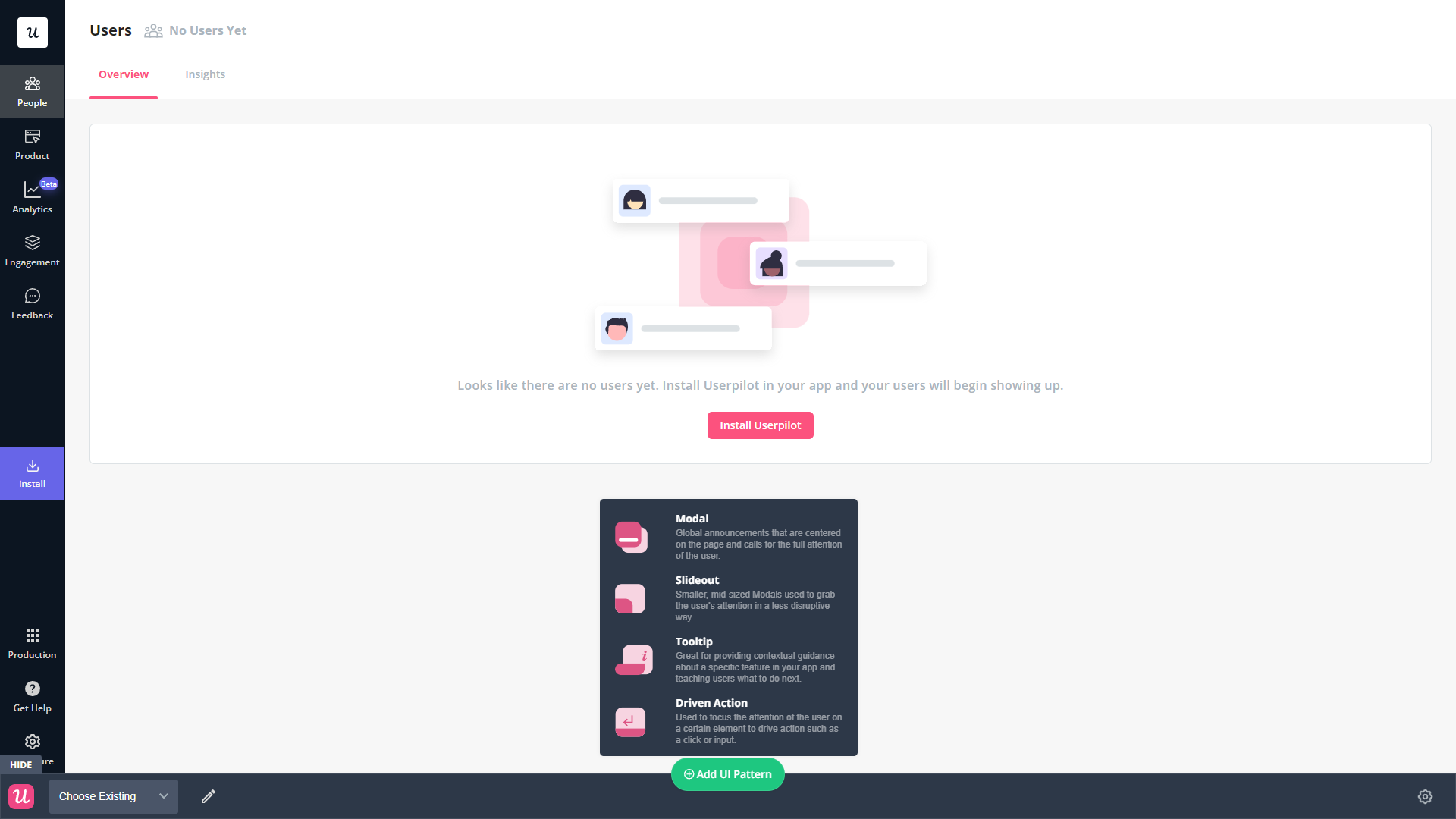
- Native tooltips: Userpilot lets you create native tooltips that show up when users hover over an element or click on an information badge. Since these native tooltips attach to the element itself, they aren’t page-dependent and will show up on any screen where that element is visible.

- Funnel analytics: Userpilot’s advanced analytics lets you create funnel reports that track the onboarding journey. You can also add filters (like name, user ID, signup date, operating system, country, etc.) and monitor the total conversion rate from the first step of the funnel to the last.
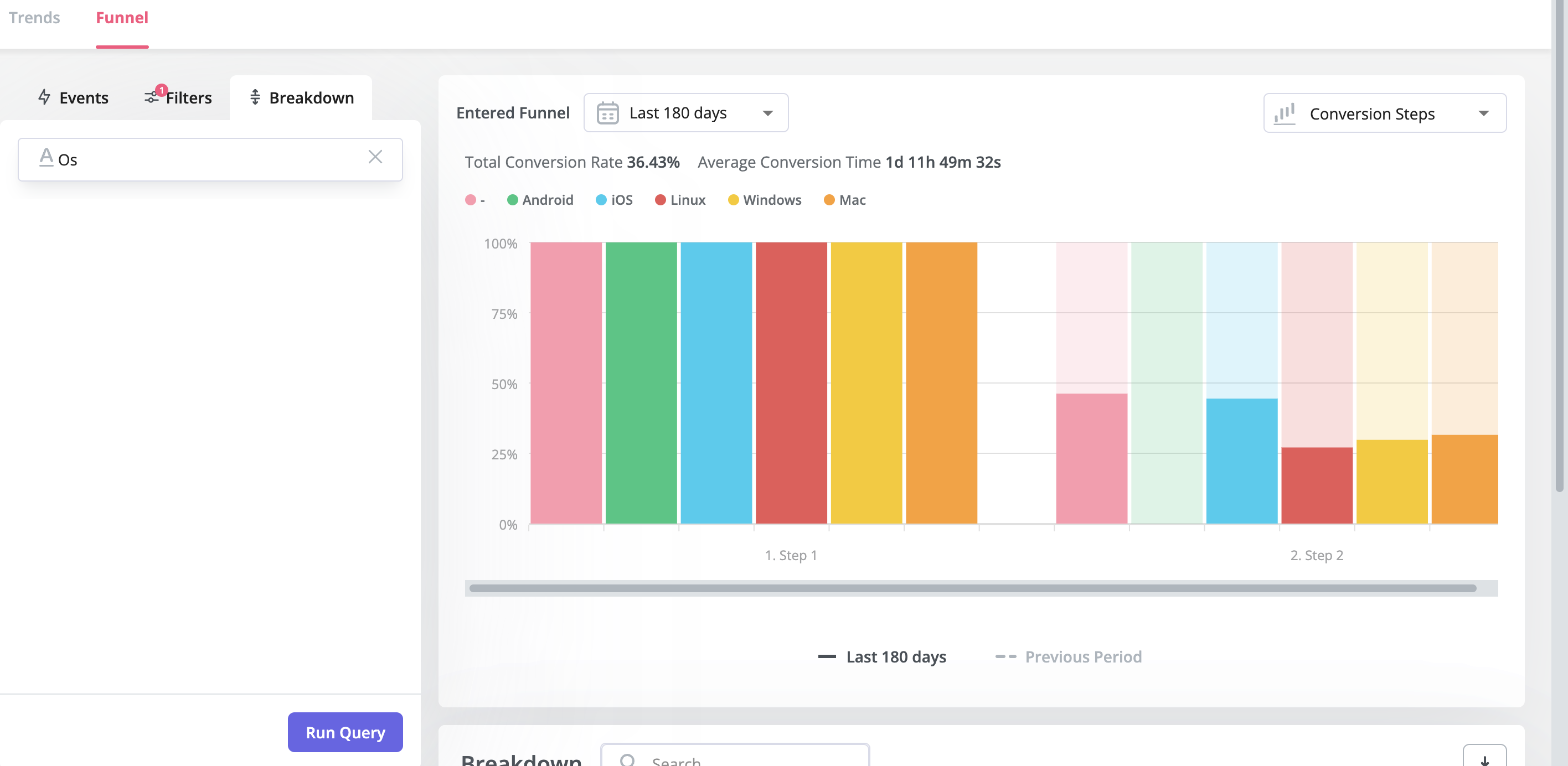
- User segmentation: Userpilot lets you segment users based on the device they’re using, where they’re located, their engagement data, or which NPS rating they selected on the latest survey. You can then filter your analytics dashboards to see which segments struggle with onboarding.
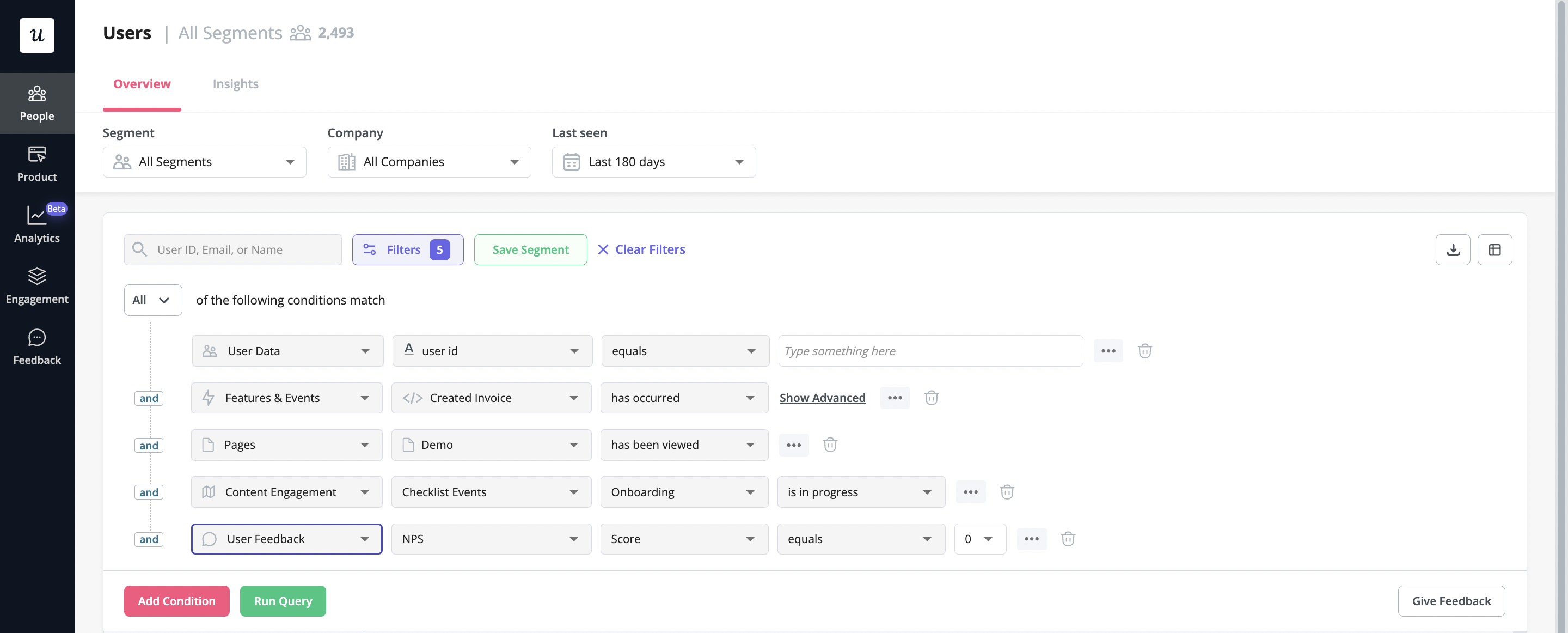
Userpilot’s user segmentation
User segmentation is essential for creating a personalized and contextual onboarding experience. Userpilot can segment users based on demographics, product usage data, NPS scores, and more. You can then trigger flows or filter analytics based on segments.
Here’s an overview of Userpilot’s customer segmentation capabilities:
- Segment conditions: Userpilot lets you form segments by adding different conditions like user data, company data, features and events, etc. You can then use these segments as analytics filters or flow triggers later on.
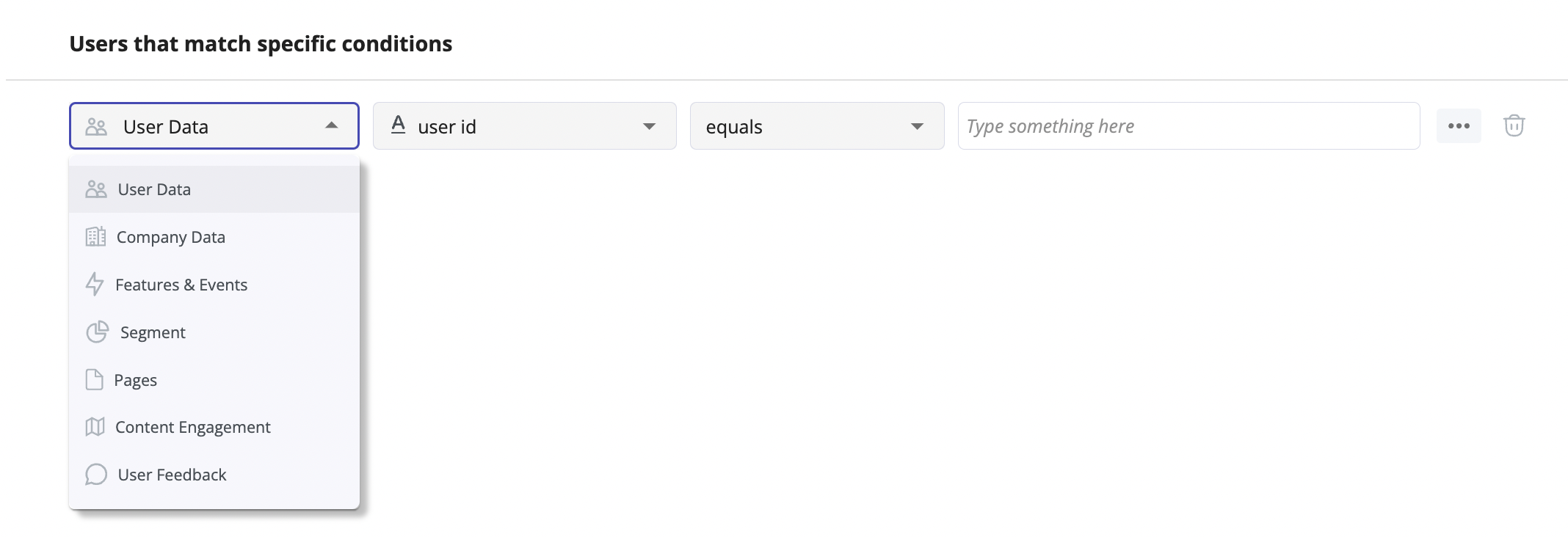
- Analytics filters: Userpilot’s product analytics and user insights dashboards can be filtered to only display data from specific segments (or companies). This will help you extract insights from certain cohorts and compare how adoption or activation varies from one segment to the next.
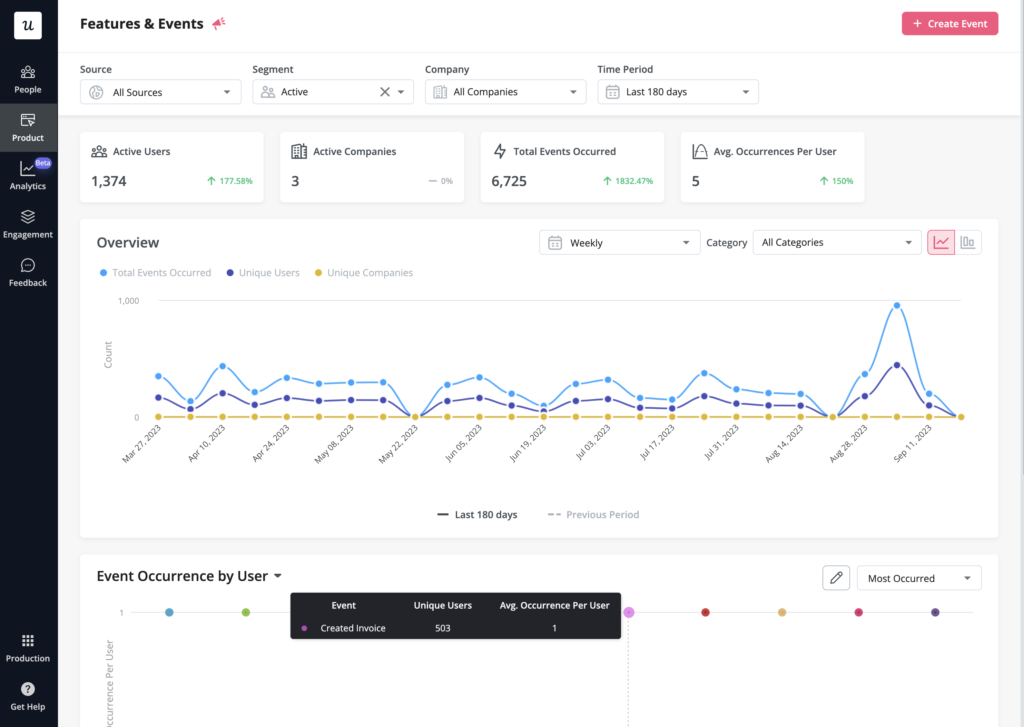
- Flow triggers: Userpilot’s audience settings let you trigger flows for specific segments or target users that meet certain conditions. You can combine this with page-specific or event-occurrence triggers to show relevant flows to the right users at the most contextual moments.

- External data: Userpilot integrates with tools like Amplitude, Google Analytics, Mixpanel, and Segment using a one-way integration. This means you can use the data inside Userpilot to build advanced segmentation and trigger contextual experiences. For more advanced use cases, the two-way integration with Hubspot lets you send and receive data, unlocking a full set of use cases.
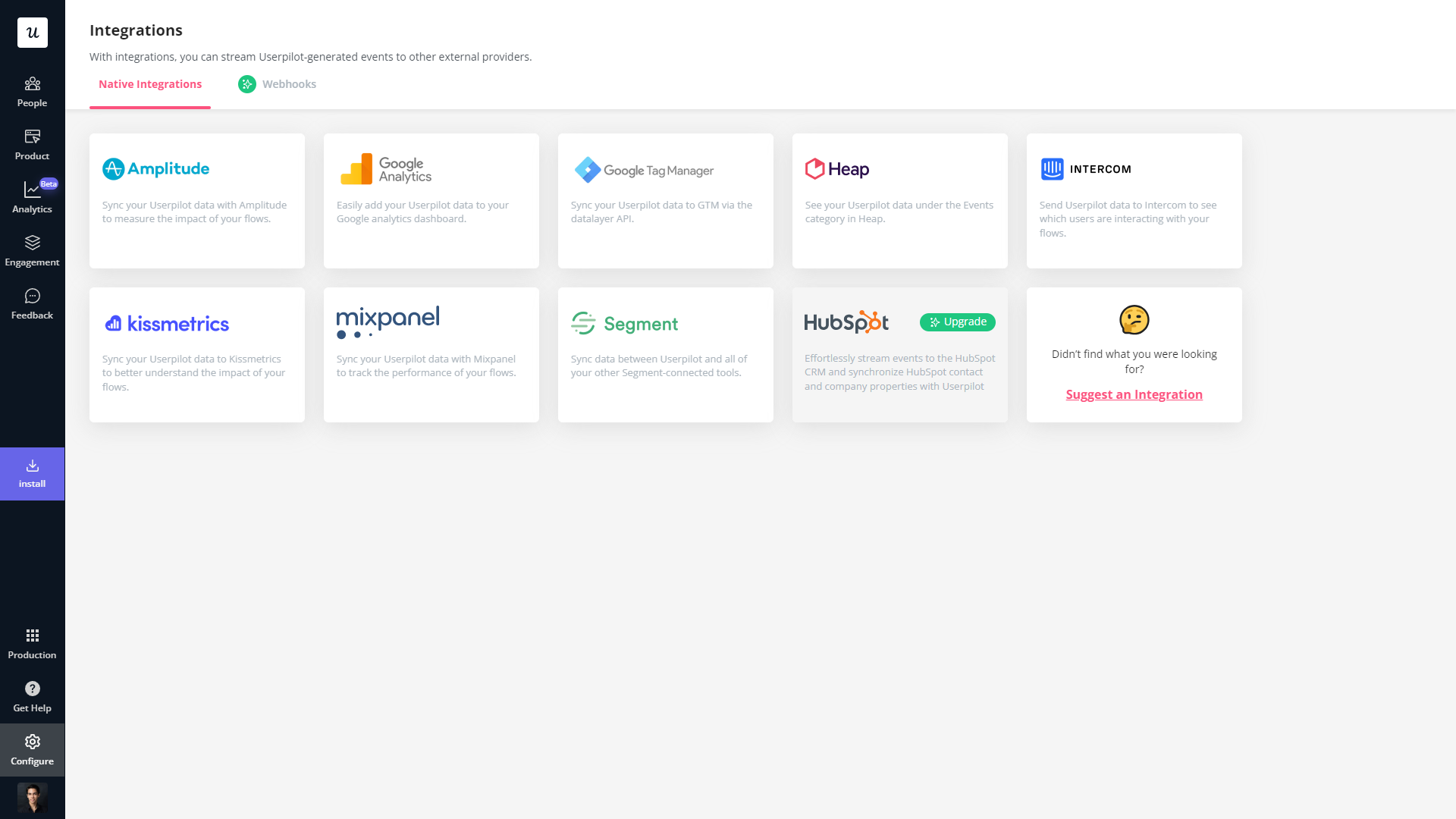
Userpilot’s Interactive user guides
Interactive user guides can help users figure out how to use your product and get them towards activation faster. Here are the Userpilot features you can use for creating interactive guides:
- No-code builder: Userpilot lets you build in-app guides using modals, slideouts, banners, etc., without writing any code. You can also tinker with audience settings to target specific segments or exclude users who meet certain conditions from seeing a particular flow.
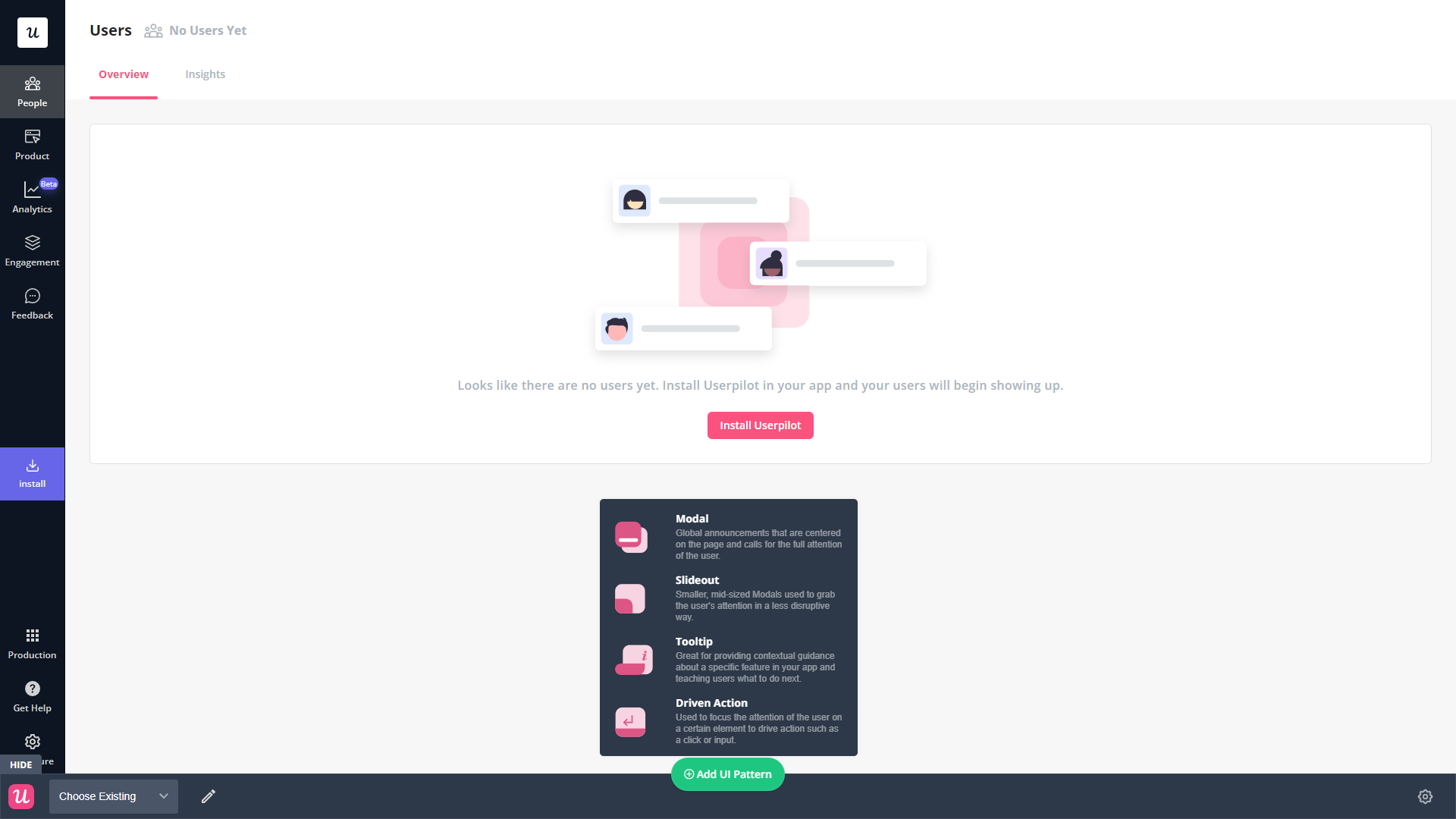
- Spotlight elements: The spotlight feature lets you add standalone UI elements like tooltips, hotspots, and driven actions that aren’t part of a multi-step flow. This makes it possible to display contextual guidance when users hover over a feature they’re interested in.
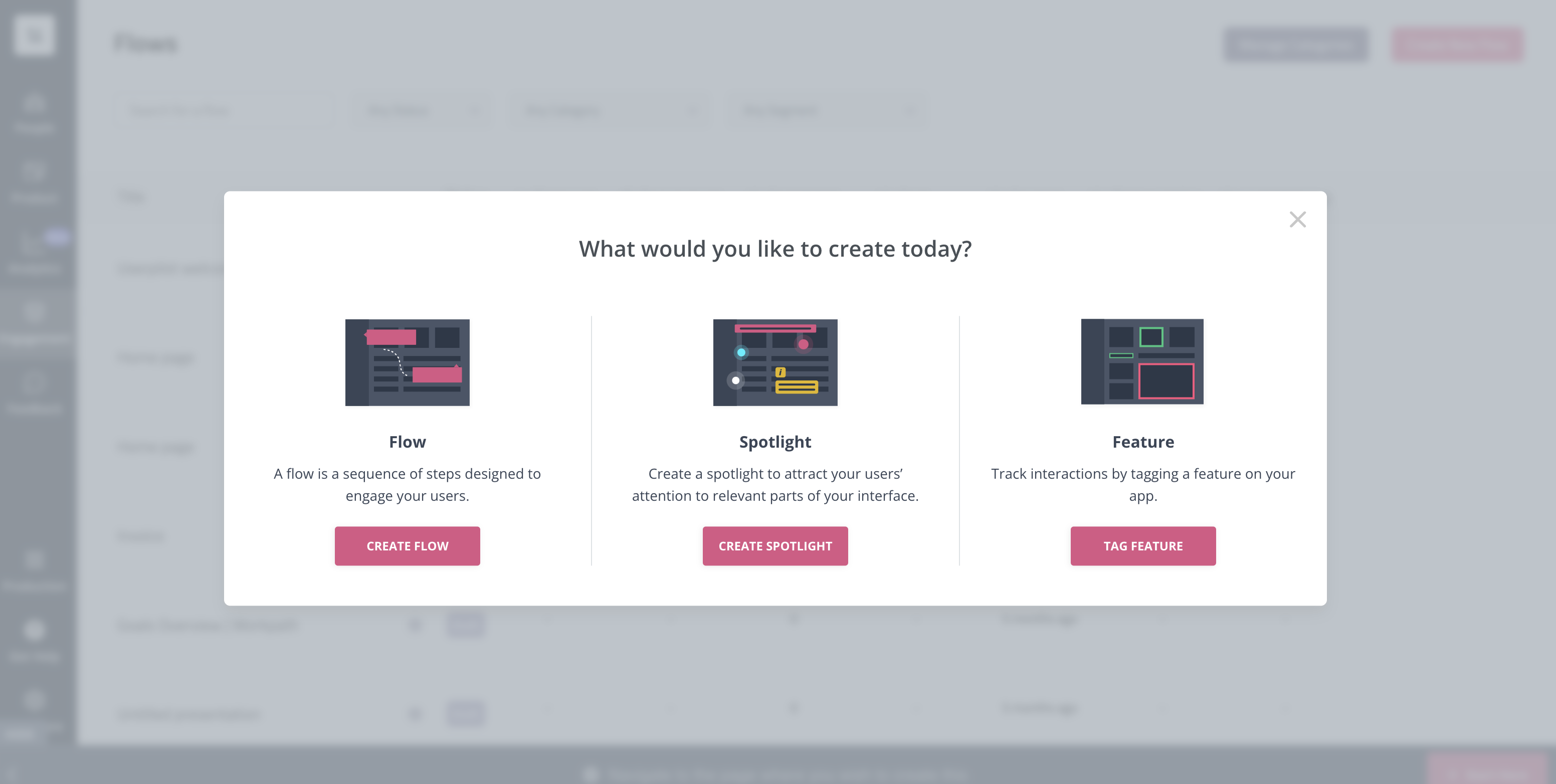
- Funnel reports: Userpilot’s advanced analytics capabilities include funnel reports that show you which pages or actions most users get stuck on. This can help you identify confusing or high-friction areas that can be removed through contextual interactive user guides.
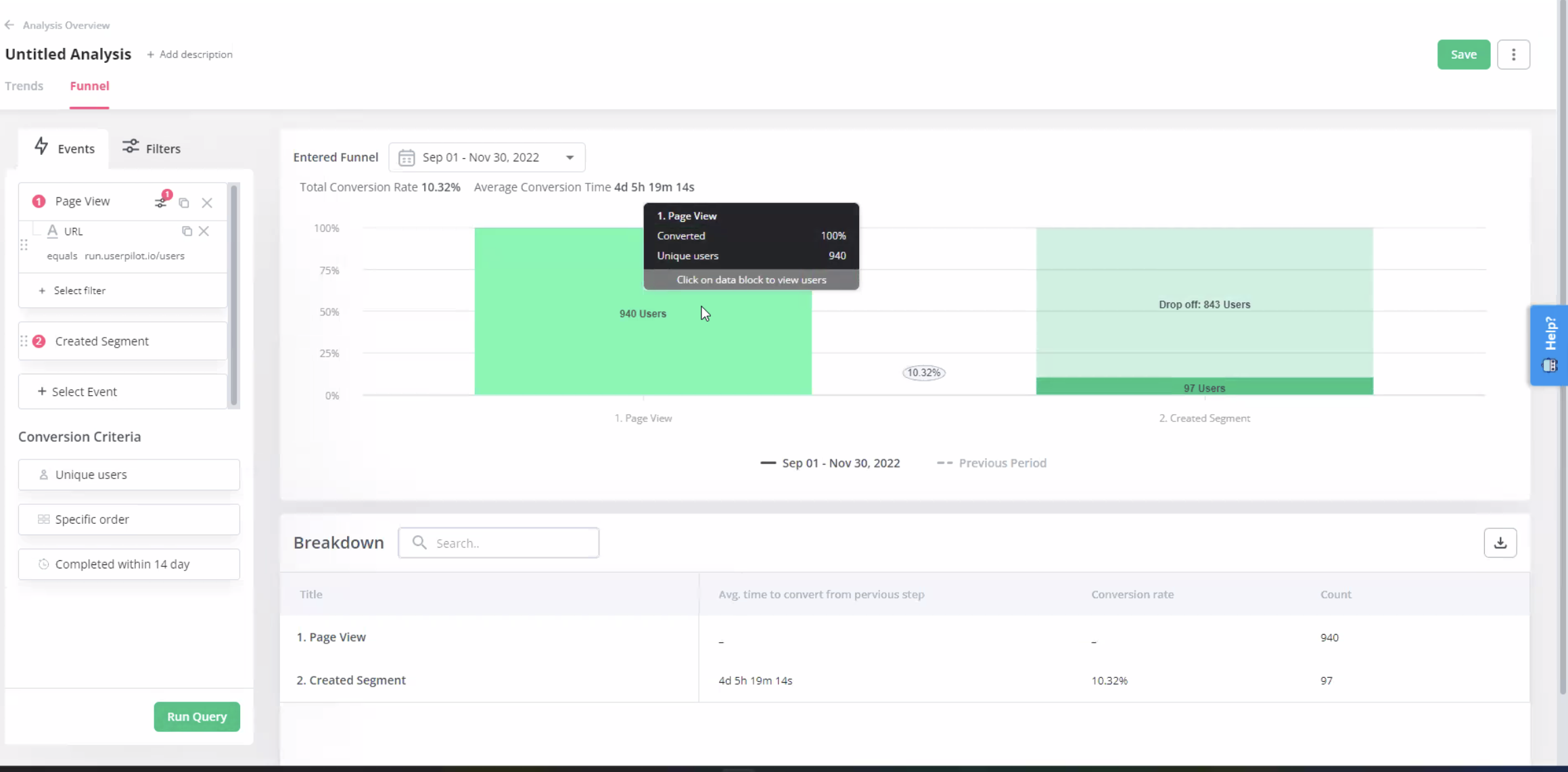
Userpilot’s in-app support
In-app support can increase customer satisfaction and retention rates. Userpilot has native in-app support features like resource centers and native tooltips as well as third-party integrations with popular support tools like Intercom to help you cover all your bases.
Here’s an overview of Userpilot’s in-app support capabilities:
- Resource center: Userpilot in-app resource centers let you add flows, checklists, external links, tutorial videos, external knowledge bases, and chatbots. You’ll also be able to view resource center analytics so you can check its performance.
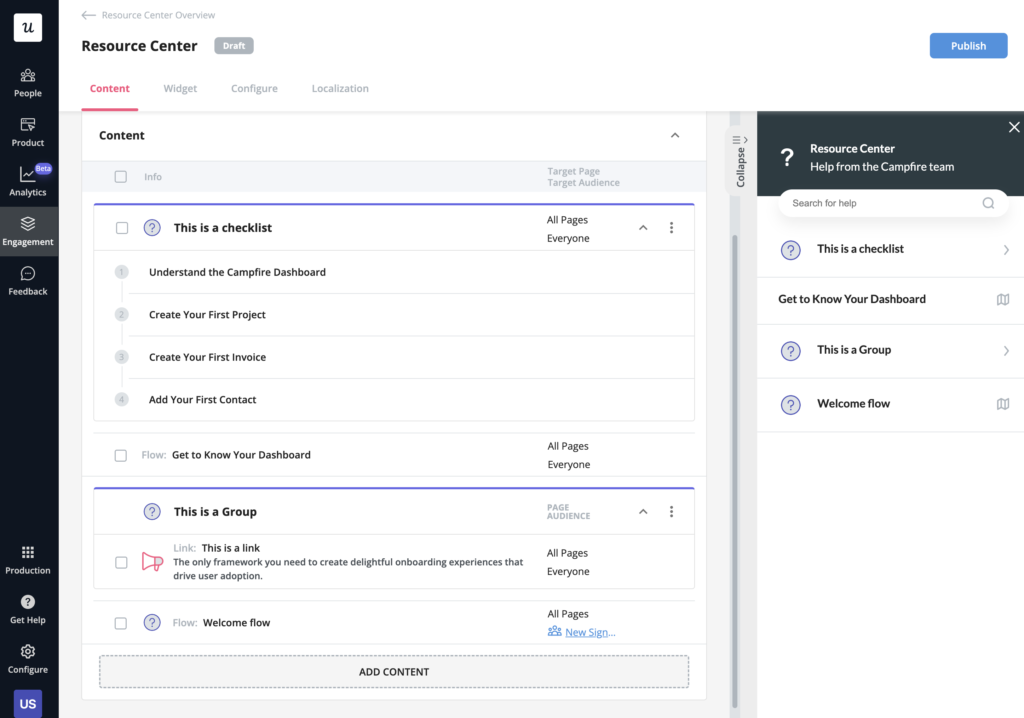
- Native tooltips: In-app support must be proactive — which is why you should insert tooltips that guide users before they even think to open the resource center. Userpilot lets you add native tooltips that appear whenever users hover over an element or click on the info badge.
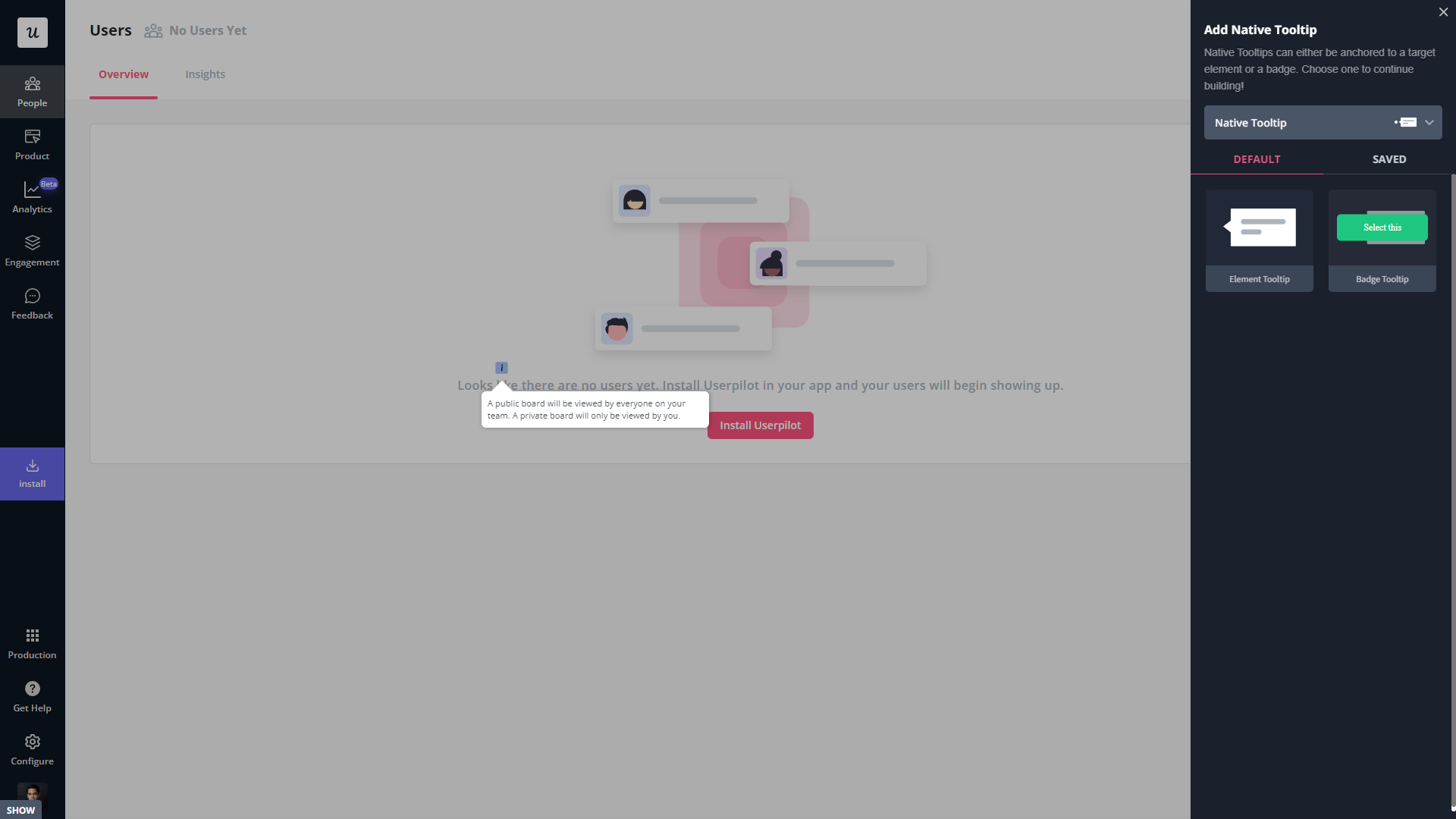
- Contextual flows: Userpilot’s trigger settings let you create contextual flows that automatically appear when a user reaches a certain page or performs a specific action. This can be used to offer in-app guidance and support whenever users try out a feature for the first time.
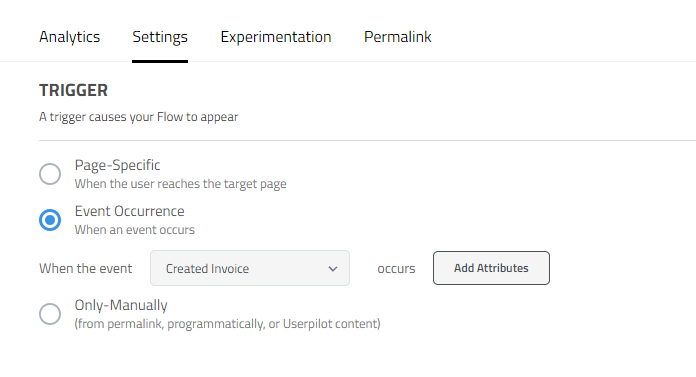
- Intercom integration: While Intercom is famous for its live chat embeds, you can do more than that by integrating it with Userpilot. You’ll see which events a user has done within Userpilot and whether or not they’ve completed onboarding to personalize support accordingly.
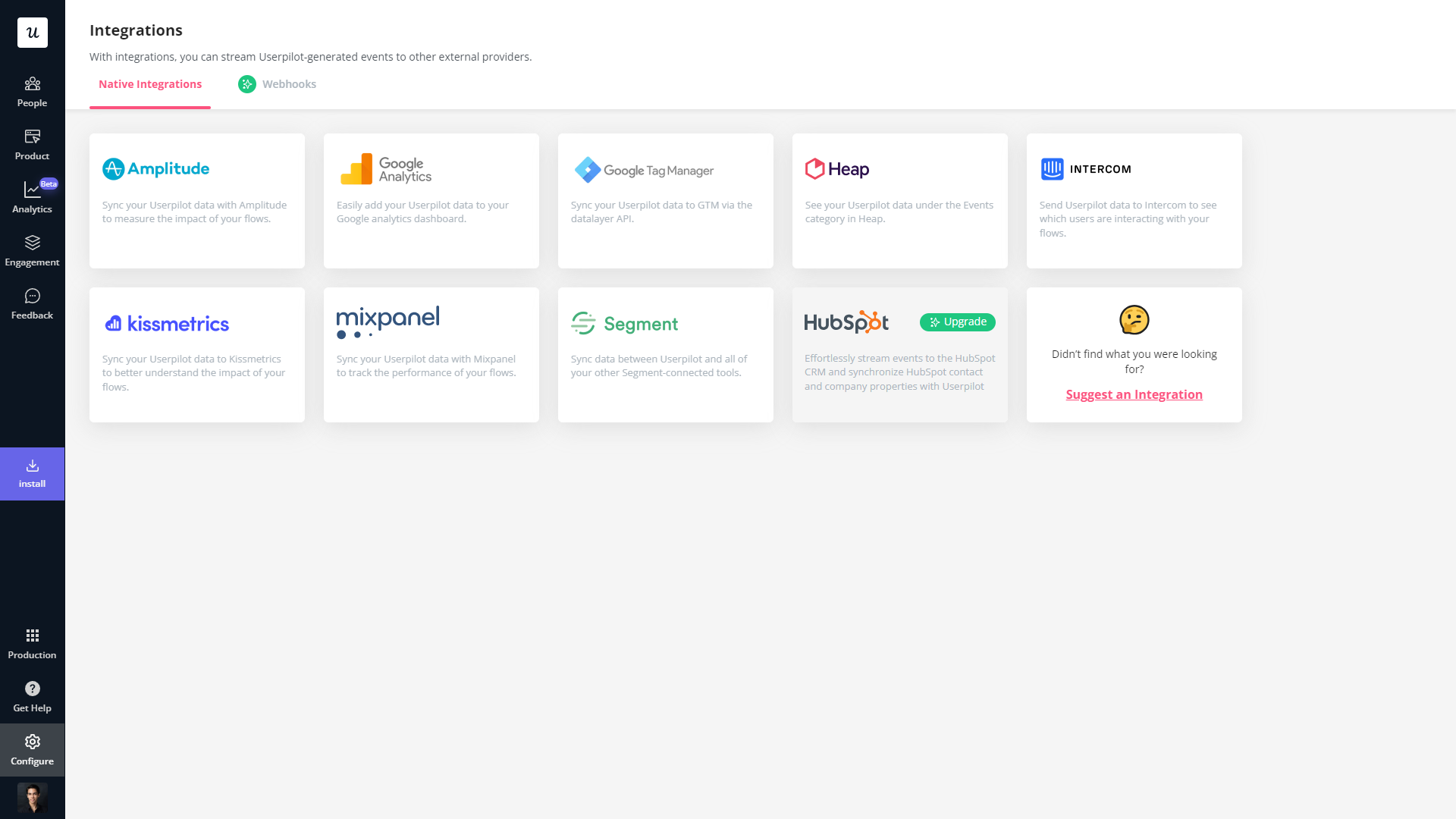
Userpilot’s self service support
Self-service support helps users solve problems themselves instead of having to reach out to a representative. Userpilot’s no-code resource center makes onboarding guides and product documentation easily accessible to users from within your product.
Here’s how you can use Userpilot to create a self-service customer experience:
- No-code builder: Userpilot’s no-code resource center lets you add modules without writing a single line of code. Module options include links, videos, flows, custom JavaScript functions, and checklists. You can also group modules into sections to help users navigate the resource center.
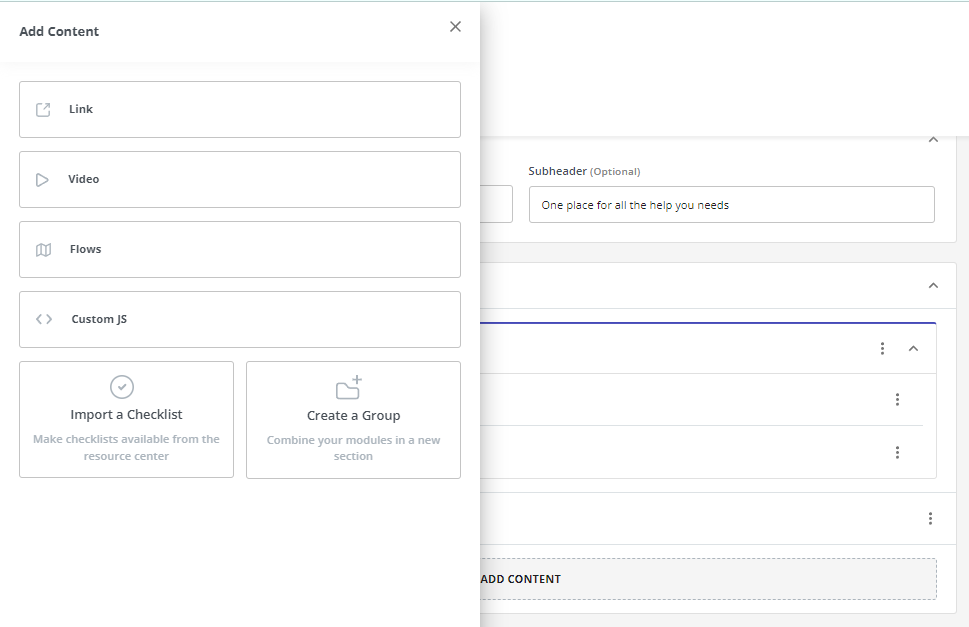
- Module segmentation: Userpilot’s segmentation settings let you hide or show specific modules within your resource center based on audience settings. This makes it possible to create modules for different user segments and hide resources that aren’t relevant to other users.
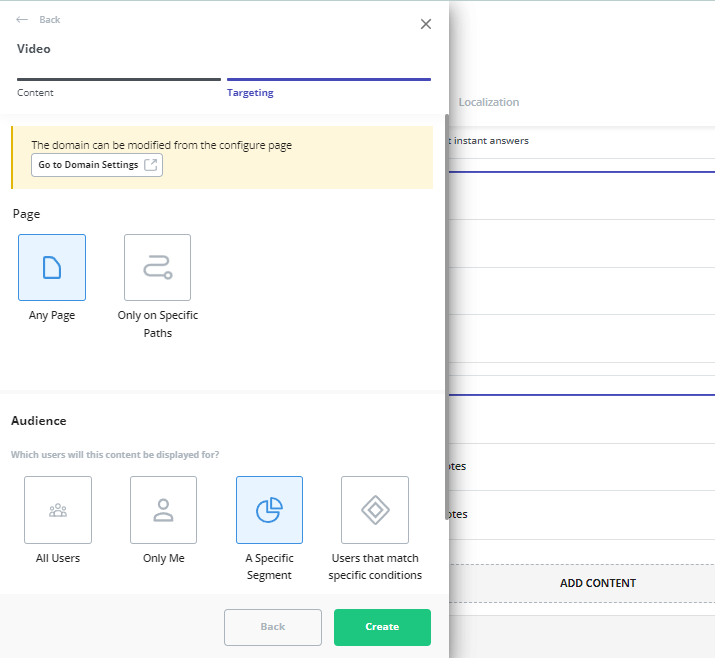
- Analytics dashboard: The dedicated analytics dashboard helps you see how many unique visitors your resource center gets, how many modules have been clicked, and the overall click rate across your user base. This will make it easier to gauge resource center performance.
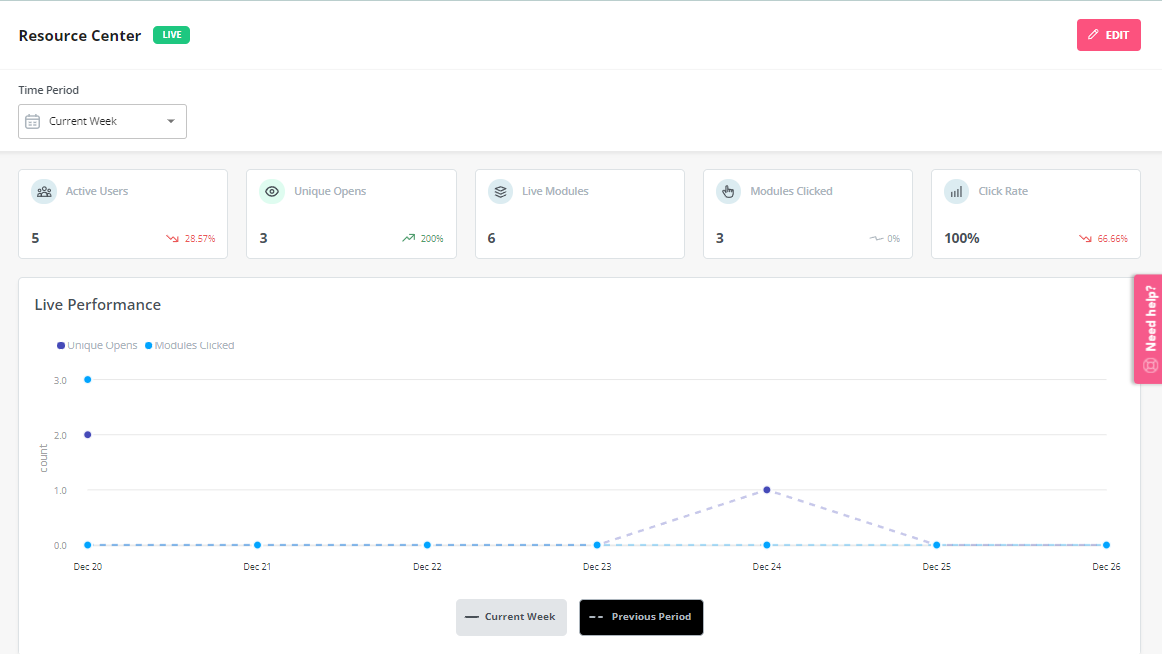
What are the pros and cons of Userpilot?
Userpilot pros
As a full-suite digital adoption platform, Userpilot has all the features you need to onboard users, track analytics, and gather feedback from customers without writing a single line of code. Here are a few pros of using Userpilot as your product growth solution:
- No-code builder: Userpilot’s Chrome extension lets you build flows, add UI elements, and tag features without writing a single line of code.
- UI patterns: There are plenty of UI patterns to choose from when using Userpilot, such as hotspots, tooltips, banners, slideouts, modals, and more!
- Startup-friendly: Userpilot’s entry-level plan gives you access to all available UI patterns so you can hit the ground running.
- Walkthroughs and flows: Build engaging interactive walkthroughs and personalized onboarding flows that target specific segments of your user base.
- Self-service support: Build an in-app resource center to help users solve problems, customize its appearance to align it with your brand, and insert various types of content (videos, flows, or chatbots) to keep your customers satisfied.
- A/B testing: Userpilot’s built-in A/B testing capabilities will help you split-test flows, iterate on the best-performing variants, and continually optimize based on user behavior.
- Feedback collection: Userpilot has built-in NPS surveys with its own unified analytics dashboard and response tagging to help you retarget users. There are other survey types to choose from and you can even create your own custom survey.
- Survey templates: There are 14 survey templates to choose from so you can gather feedback on specific features or run customer satisfaction benchmarking surveys like CSAT and CES.
- Advanced analytics: Userpilot lets you analyze product usage data, monitor engagement on all in-app flows, and use the data to create user segments that are based on behaviors instead of demographics.
- Event tracking: Userpilot’s no-code event tracking lets you tag UI interactions (hovers, clicks, or form fills) and group them into a custom event that reflects feature usage.
- Third-party integrations: Userpilot has built-in integrations with tools like Amplitude, Mixpanel, Kissmetrics, Segment, Heap, HubSpot, Intercom, Google Analytics, and Google Tag Manager so you can share data between all the solutions in your tech stack.
Userpilot’s cons
Of course, no tool is perfect and there are a few cons to consider before choosing Userpilot as your user onboarding or product growth solution:
- Employee onboarding: Currently, Userpilot only supports in-app customer onboarding.
- Mobile apps: Userpilot doesn’t have any mobile compatibility which could make it difficult for developers with cross-platform applications to create a consistent user experience for both versions of their product.
- Freemium plan: There’s no freemium Userpilot plan so those bootstrapping their startup and need sub-$100 solutions should consider more affordable onboarding platforms like UserGuiding or Product Fruits.
What do users say about Userpilot?
Most users laud Userpilot for its versatile feature set, ease of use, and responsive support team:
I recently had the pleasure of using Userpilot, and I must say it exceeded all my expectations. As a product manager, I’m always on the lookout for tools that can enhance user onboarding and improve overall user experience. Userpilot not only delivered on these fronts but also went above and beyond with its impressive new features, unparalleled ease of use, and truly exceptional customer support.
What truly sets Userpilot apart is its outstanding customer support. Throughout my journey with Userpilot, the support team has been responsive, knowledgeable, and genuinely dedicated to helping me succeed. Whenever I had a question or encountered an issue, their support team was always there to assist promptly, going above and beyond to ensure my concerns were addressed effectively.

Source: G2.
Of course, other users are also kind enough to share constructive criticism regarding specific features like event tracking filters:
“The filtration while analyzing specific events is a little confusing. Understanding of custom properties and data management configuration could have been more organised.”

Source: G2.
Userpilot’s pricing
Userpilot’s transparent pricing ranges from $249/month on the entry-level end to an Enterprise tier for larger companies.
Furthermore, Userpilot’s entry-level plan includes access to all UI patterns and should include everything that most mid-market SaaS businesses need to get started.

Userpilot has three paid plans to choose from:
- Starter: The entry-level Starter plan starts at $249/month and includes features like segmentation, product analytics, reporting, user engagement, user feedback, and customization.
- Growth: The Growth plan starts at $499/month and includes features like resource centers, advanced event-based triggers, unlimited feature tagging, AI-powered content localization, EU hosting options, and a dedicated customer success manager.
- Enterprise: The Enterprise plan uses custom pricing and includes all the features from Starter + Growth plus custom roles/permissions, access to premium integrations, priority support, custom contract, SLA, SAML SSO, activity logs, security audit and compliance (SOC 2/GDPR).
Conclusion
There you have it.
It should be easier now to make an informed decision whether Intercom is your go-to option for Customer experience. Ultimately, the best choice will depend on your product and current needs.
If you’re looking for a better alternative to Intercom for Customer experience, book a Userpilot demo today to experience firsthand how it can enhance your user experience and drive product growth!
![]()
Looking for a Better Alternative for Customer Experience? Try Userpilot


